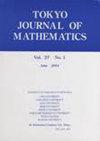负连分数的丢番图近似
IF 0.4
4区 数学
Q4 MATHEMATICS
引用次数: 1
摘要
我们证明了$n$ -负展开式$x$的第一次收敛的分母$Q_n$的增长率和a.e. $x$的近似率:$$ \frac{\log{n}}{n}\log{\left|x-\frac{P_n}{Q_n}\right|}\rightarrow -\frac{\pi^2}{3} \quad \text{in measure.} $$。在证明过程中,我们重新证明了已知的一些鼓舞人心的结果,即负连分数的算术平均值在尺度上收敛于3,尽管其下极限为2,上极限几乎处处为无穷。本文章由计算机程序翻译,如有差异,请以英文原文为准。
Diophantine Approximation by Negative Continued Fraction
We show that the growth rate of denominator $Q_n$ of the $n$-th convergent of negative expansion of $x$ and the rate of approximation: $$ \frac{\log{n}}{n}\log{\left|x-\frac{P_n}{Q_n}\right|}\rightarrow -\frac{\pi^2}{3} \quad \text{in measure.} $$ for a.e. $x$. In the course of the proof, we reprove known inspiring results that arithmetic mean of digits of negative continued fraction converges to 3 in measure, although the limit inferior is 2, and the limit superior is infinite almost everywhere.
求助全文
通过发布文献求助,成功后即可免费获取论文全文。
去求助
来源期刊

Tokyo Journal of Mathematics
MATHEMATICS-
CiteScore
0.70
自引率
16.70%
发文量
27
审稿时长
>12 weeks
期刊介绍:
The Tokyo Journal of Mathematics was founded in 1978 with the financial support of six institutions in the Tokyo area: Gakushuin University, Keio University, Sophia University, Tokyo Metropolitan University, Tsuda College, and Waseda University. In 2000 Chuo University and Meiji University, in 2005 Tokai University, and in 2013 Tokyo University of Science, joined as supporting institutions.
 求助内容:
求助内容: 应助结果提醒方式:
应助结果提醒方式:


